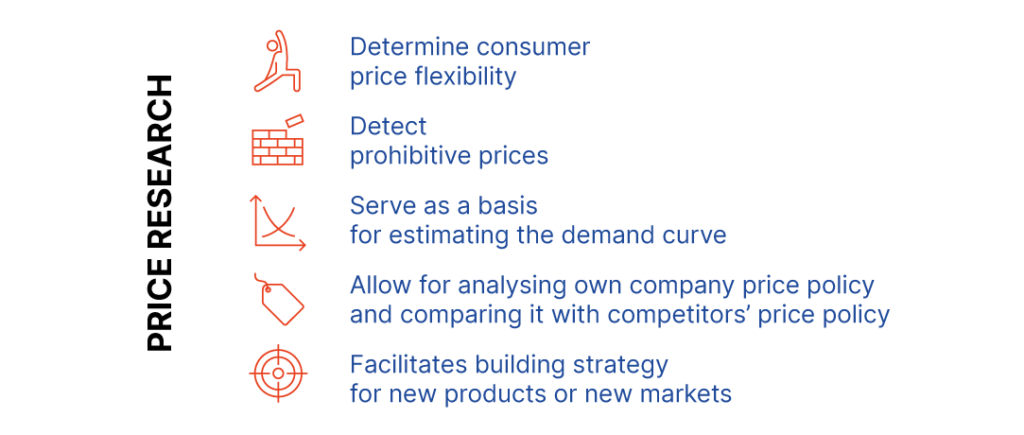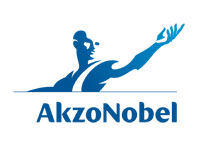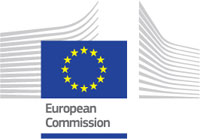Price
research
Table
of contents
- What is price research?
- Why is price research so important?
- What kind of information does price research deliver?
- When should price research be carried out?
- What techniques do we apply to price research?
- What methods do we use to carry out price research?
- Who should use price research?
- Our Clients
- Why choose our offer?
- Price research – Price list
- FAQ
Price research focuses on analysis of price sensitivity of consumers. It enables defining the optimal price level, which taking into account target groups’ preferences, will contribute to maximising sales profit. This kind of research allows to estimate the size of demand and supply; hence strategy building is easier and involves lower risk.

Why is price research so important?

While company-wise price is the source of income, it might evoke negative emotions in consumers. For them, price reflects the product value and becomes its equivalent. Price research allows us to minimise these negative feelings in consumers, whilst maximising company profits.
Optimising prices of commodities and services is one of the key elements of strategy building. The price level determines the size of demand; hence it is essential to know, at what price level the company will maximize profits and maintain its competitive advantage or cause that the consumers will lose their interest in company’s offer.

What kind of information does price research deliver?
Consumers know best the answer what it the optimal product price, therefore, specialised price research is the best source of information about the optimal product price.
Price research also provides us with the knowledge about price levels, which customers find prohibitive. It allows us to estimate the demand and supply levels and gives us the opportunity to compare company’s price policy with its competitors.
Price is one of the key elements driving company’s operation. Thus, information about price flexibility is essential for building its position in the market and sustaining competitive advantages.

When price research should be carried out?

Price research can be carried out at any time, as the price sensitivity of the consumers can change rapidly, as it is shaped by various factors coming from a changing environment. Some of these factors are inflation, risk of unemployment or growing social unrest.
There are also some situations when price research is the key to success.
LAUNCHING A NEW PRODUCT
Too high or too low price might be the decisive factor for a product success or failure. Since product launch happens only once, all later changes in prices positioning involve a risk of losing confidence in product value. Therefore, some effort should be made in order to determine the optimal price level.
ENTERING A NEW MARKET
Entering a new market might be quite a challenge, as new market means new consumers. In these situations, applying the same price policy as before might be a mistake. While entering a new market, we should know our target groups and find out what price level is acceptable for them.
CHANGES IN COMPANY’S PRICE POLICY
While we seek optimal price level, applying the trial-and-error method might prove risky and costly. Once established price level is difficult to change without affecting brand trust. Therefore, each time a change in company price level is planned, price sensitivity should be researched.
What techniques do we apply to price research?
We use the following techniques in our price research projects:
CATI
Telephone interview
CAWI
Online survey
PAPI
Pen and paper survey
Face to face FGI
Group interviews
FGI on-line
Group interviews
Ethnography
Observation and description
IDI
Individual face to face in-depth interviews
ITI
Individual online in-depth interviews
CAPI
Computer-Assisted Personal Interviews
Dyads, tryads
Small group interviews
User tests
Product tests, consumer’s assessment
DR
Desk research, secondary data analysis
MOBI
Face-to-face survey on mobile devices
Eye tracking
Biometric research – tracking the eye movement
Face tracking
Biometric research – facial expression analysis
Mystery e-mailing
Mystery shopper – testing customer service via email
Mystery calling
Mystery shopper – testing customer service via phone
Mystery shopping
Mystery shopper – testing face-to-face customer service
Project design methods
Design thinking, iterative design
Motion tracking
Motion capture - XSENS, Vicon, Kinect
Auditorium questionnaire
A questionnaire filled in by a specific group being in the same room
EMG
Biometric research – analysis of micro expression of facial muscles
EEG
Biometric research – brain activity analysis
GSR
Biometric research – the galvanic skin response
What are the methods we use to carry out price research

The methods applied to price sensitivity analysis start from the assumption that product price reflects its quality. Price research contributes to product positioning and choosing a marketing strategy tailored to the customers’ price expectations. However, they cannot be used to predict future consumer behaviour, resulting from changes in price.
Price Senstivity Meter – PSM
The Price Sensitivity Meter is a tool for determining consumers’ price preferences. In order to research price flexibility, four key questions are asked:
- What price for product X seems to be too low and might imply low quality?
- What price for product X seems low?
- What price for product X seems high, yet acceptable?
- What price for product X seems to be too high and unacceptable?
While analysing data, apart from cumulative distribution of answers for each question, two derived distributions are added:
- Not expensive (100% – expensive),
- Not cheap (100% – cheap).
The analysis includes the following points:
- Indifference Price Point (IPP) – indicates the price, which is considered by the majority neither too high, nor too low. This point defines the neutral price (consumers consider that purchasing a product at such price, is a good opportunity)
- Optimal Price Point (OPP) indicates the price level, at which the lowest number of potential customers would not buy a product because of its price.
- Point of Marginal Cheapness (PMC) – indicates the price level, at which we will lose more because of the concerns about product quality than we will gain because of the product being purchased by consumers taking advantage of a bargain. It defines the limits for low price.
- Point of Marginal Expensiveness (PME) – marks a price level, above which consumers deems too high, regarding the product quality and its usefulness. If defines the limits for high price.
Direct Price Acceptance – DPA
The DPA method (also known as price ladder) is used for defining different variants of product prices and enables predicting future consumer behaviour, resulting from changes in prices. It relies on asking a series of questions to a respondent about them buying a product at different, previously established, price levels. The product at a chosen price is presented to a costumer, who assesses how likely they are to buy it. If the likelihood of purchasing at this price is high, the next question will be about buying this product at a higher price. Conversely, if the likelihood is low, the next question will be about buying the same product at a lower price. The questions are repeated until we have tested the highest or the lowest price, according to the previously established price levels.
Brand Price Trade-Off (BPTO)
This is a simplified version of Conjoint research, which allows to measure the price flexibility of demand. Two elements are factored in: brand and price. The respondent chooses an item from a list of similar products of different brands, while the price of the researched product is the lowest at the first stage of the research. At the next stages, the respondent receives the same list with same prices, except from the researched product, which is now more expensive than at the first stage. The research is repeated until the point the respondent chooses the highest or the lowest price we want to test.
Which methods should I choose?
These methods can be applied separately or complementarily.
PSM enables researching new products and those, which existed before, but now their properties are being changed (for example its graphic layout). It measures price flexibility and defines upper and lower limit for acceptable prices. However, it cannot assess potential demand, for which DPA might be used.
DPA enables researching new products and assessing potential sales levels. However, it does not deliver information about the product characteristics that customers appreciate the most and because of which they do not buy competitive products.
BPTO cannot be used to research on new products, but it is suitable for analysing the situation when price or other properties have changed. Its biggest advantage is the possibility of comparing with competition and testing what will happen if we or our competitors change the prices.
Who should use price research?
- Anyone who wants to know the price sensitivity of their customers
- Anyone who wants to gauge the level of demand
- Anyone who wants to change their price policy
- Anyone who wants to compare themselves to their competitors
- Anyone who wants to gain market recognition
- Anyone who wants to increase their sales
- Anyone who wants to enter new markets
- Anyone who wants to launch a new product
- Anyone who wants to prepare company development strategy
- Anyone who wants to prepare for the future
- Anyone who wants to obtain a competitive advantage

Do tej pory mieliśmy okazje współpracować z różnymi firmami, którym zależało na zbadaniu wrażliwości cenowej. Zrealizowane badania pomogły w tworzeniu skutecznej strategii, dalszej realizacji planów oraz pozyskiwaniu nowych klientów.
Why chooseour offer?

Since 1996, we have been carrying out price research. Owing to the highest quality standards, professionalism and acquired experience, we take great pride in high indicator of returning customers.
We know how to best obtain the information necessary for effective planning of strategic actions in a company.
Building a competitive business is easier when using our research and analyses.
We will be happy to answer your questions and suggest research methods most suitable for each individual case. We kindly invite you to get familiar with our offer.
Price research - Price list
The price research, which we carry out, is customised and tailored to each client’s needs. Therefore, we strongly recommend contacting us, in order to obtain a detailed price list.
FAQ
Price research allows us to define the price sensitivity level. They determine, what price level is acceptable for customers and what price will be prohibitive for them.
cena będzie dla nich zaporowa.
It is the relationship between the price level and the willingness of consumers to buy a product. It determines the price ranges that are the most optimal, that maximize demand.
This research allows us to define optimal prices, which are most likely to maximise the profits. Consequently, these prices maximise the long-term gains. Price research also determines the price level, which target groups find “prohibitive”, which will lover the demand.
Yes. Price research is not only carried out for new products. It is recommended to periodically carry out price sensitivity research of already existing products.
Research timeframe is discussed individually with each client. However, the average project duration is 5-6 weeks. This can be shortened or extended, depending on adopted methodology and planned scope of analysis.
Price sensitivity of clients can change due to various factors, such as growing inflation, or the unemployment problem. Hence, the price research should be conducted periodically. We will be happy to suggest the optimal time interval, tailored to each company’s needs.
The cost of research is discussed individually with each client, as it depends on adopted methodology and scope of the research.
PSM, DPA or BPTO methods can be used separately or complementarily. Mixing them gives the best results and allows to come to the most valid conclusions, which will be the foundation for creating optimal price policy of a company. The choice of suitable methods depends, however, on the client’s needs. Our multidisciplinary team will help you choose the suitable research pathway for meeting your goal.
We support all the industries

































